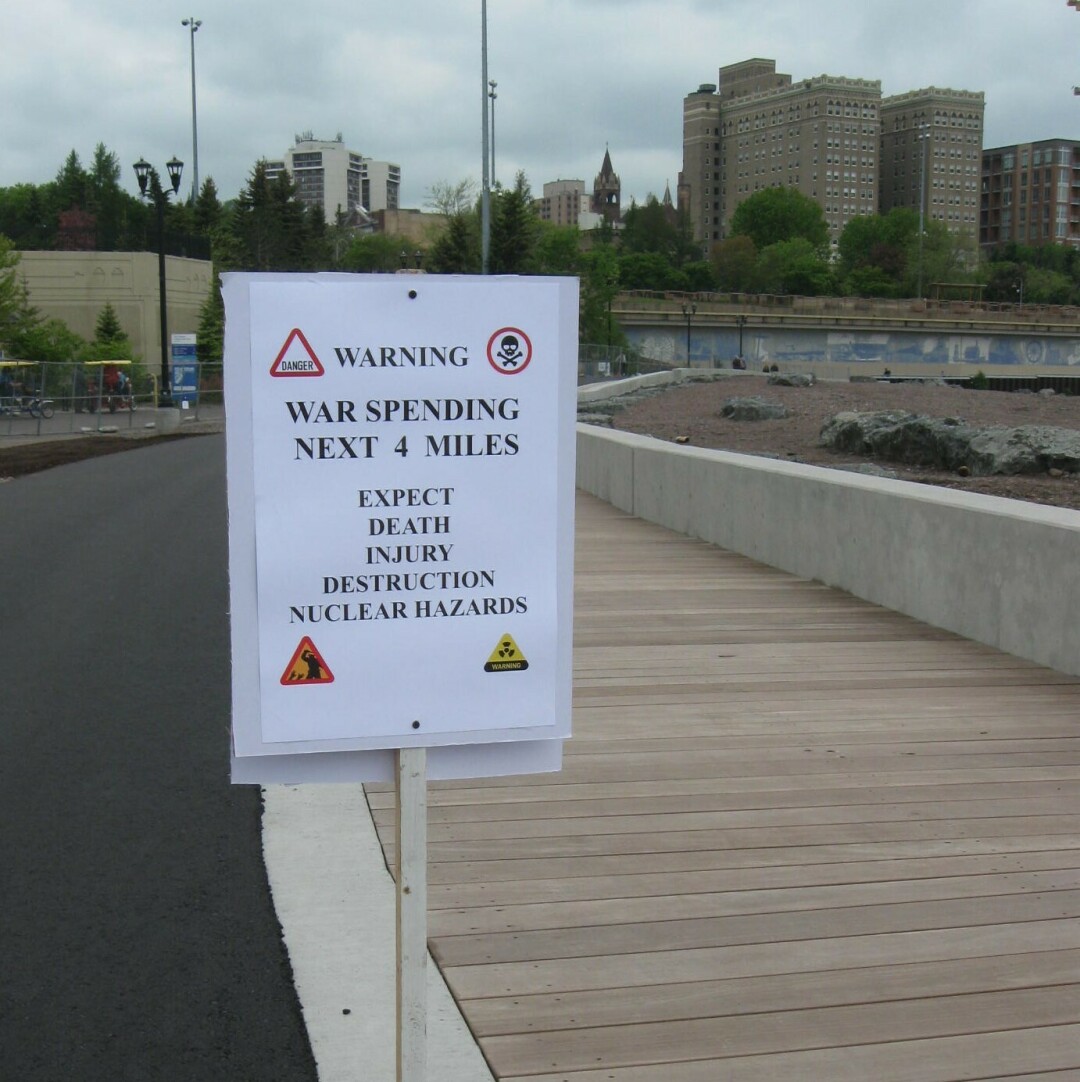Mapping military spending

How big is a trillion dollars?
Understanding government spending numbers can be difficult. The numbers are so huge most people can’t visualize the magnitude.
We understand what a hundred dollars will buy (darn little), the price of a car, or maybe the $300,000 needed to buy a house. But we don’t really comprehend a billion dollars.
And a trillion is 1000 billions. So the $4.8 trillion in total federal spending is like the distance to Pluto. It is just big and has no practical meaning.
On Memorial Day members of Grandmothers For Peace and Veterans For Peace* organized a “Costs of War Walk” to help people think about ALL the costs of war (human, economic, environmental and financial). They also wanted people to visualize the massive size of Pentagon spending. To do this they put the war spending into perspective using a known, local landmark – the Lake Walk.
They marked off distances along the way to represent the amount of spending on various federal government programs. This illustrated in a tangible way the stark contrast between federal spending on war and a number of important and popular government activities.
The Lake Walk from the Marine Museum to Brighton Beach is 7.2 miles long. We can let this distance represent the $1.485 trillion federal discretionary budget. On this scale the $934 billion war related spending in the discretionary budget covers 4.5 miles. This is the distance from the Marine Museum to East High School (more on these numbers below).
All other federal government operations get only 2.7 miles of funding. Many important programs are measured in tenths of a mile.
All the essential functions of the federal government must survive on 37% of the nation’s disposable income. A partial list shows the importance these activities which include:
Federal courts and law enforcement; Justice Department, federal district attorneys, FBI, federal crime labs, Secret Service, treasury agents, border patrol, and other agencies
Business regulation and support; bank oversight, deposit insurance (FDIC), investment safeguards, Securities and Exchange Commission, Small Business Administration, Air Traffic Controllers, aircraft safety (FAA), economic development block grants, science research. Consumer protection; truth in advertising, loan protections, debt collection standards, consumer fraud, product safety, Consumer Financial Protection Bureau, Federal Trade Commission. Employment; child labor law enforcement, unemployment, pension protections, minimum wages, workplace safety (OSHA), equal employment opportunity. Health social services and safety; Food and Drug Administration, National Institutes of Health, the Centers for Disease Control and Prevention, Medicare, Medicaid, Childrens Health Insurance Program (CHIP), nutrition programs (WIC), food stamps, the Environmental Protection Agency, automobile safety. Agriculture; price supports, crop insurance, western water projects, Extension Service, agricultural research. Housing; home mortgage guarantees (FHA), low income housing, fair housing standard Veterans home loans, mortgage agencies (Feddie Mac and Fanny Mae). Disaster relief; FEMA, flood control, National Weather Service. Education; Pell Grants and student loans, education funding, Public Broadcasting. Public infrastructure; highways, airports, sea ports, water and sewage systems, National Parks.
All this and more allows the economy to work and safeguards the well being of all of us. Yet we continuously shortchange these vital public services in order to feed the war machine.
Coming back to the Lake Walk visualization, let’s look at how some essential services fit into the picture. Of the 15 cabinet level departments, Transportation comes in number three in funding (after Defense and the the Veterans Administration).
The DOT funds all federal transport-ation-related activities for vehicles, aviation, rail, pipelines, and marine transport. In FY 2021 Congress appropriated $107.2 billion for the DOT. This was 7.2% of the discretionary budget or 0.52 mils on the Lake Walk scale.
Stop and think about this!
Transportation is absolutely essential to people, business and the economy. The operations, safety, maintenance and much of the construction of our national transportation infrastructure – highways, seaports, airports, pipelines and public rail systems – gets one dollar for every nine spent on war, preparation for war, and cleaning up after the wars (veterans hospitals and disability benefits).
You think our priorities might be messed up?
Here are some other examples using the Lake Walk scale:
• Health and Social Services (4th larg-est discretionary item) is $ $96.4 billion or 0.5 mile
• Education gets $66.6 billion and takes up 0.3 mile.
• Housing and Urban Development is $47.9 billion or 0.2 mile
• National Institute of Health (health research) is $43 billion or 0.19 mile
• Department of Justice is $31.7 billion or 0.15 mile.
• Head Start Programs received only $10.7 billion and are 0.05 mile or only 264 feet!
• Centers for Disease Control and Prevention is $6.7 billion for 0.03 mile
• Environmental Protection Agency is $6.7 billion and also 0.03 mile.
• National Park Service (“our greatest idead”) receives only $2.8 B for 0.01 mile or 53 feet!
Nothing shows how messed up this is than the funding for the De-partment of State vs Defense. At $44.1 billion, diplomacy gets only 3% of discretionary spending while the Pentagon routinely gets more than 50% (using $741 billion for DOD – See below).
What does this say about our real desire to avoid war and get along peacefully with our neighbors?
Making sense of the huge federal budget can be difficult. Functional budget categories and funding sources can be scattered in many departments. So measuring total war-related spend-ing can vary with what one counts.
One estimate is $934 billion (63%) which includes discretionary spending from all agencies.
Another analysis says it is $1.2 trillion and adds war-related manda-tory spending like veterans disability payments, retirements and interest on the debt caused by war.
A commonly used figure counts just the DOD base budget, the Overseas Contingency Fund (direct war costs), and nuclear weapons spending by the Department of Energy. By this calculation “defense” gets $741 billion (50%).
However you slice the salami spending on war is huge. Plus it is wasteful, largely unnecessary and doesn’t make us safer, more secure or more prosperous.
People need to see the stark contrasts between war spending and everything else. Then people can demand better priorities for spending our “hard-earn-ed tax dollars.”
* Full disclosure: I am a member of Veterans for Peace and an Associate Member of Grandmothers For Peace.
